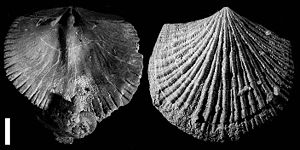- Orthida
-
Orthida 
Hesperorthis martinsonii (Bassett, 1974)
Zeitraum Kambrium bis Perm 540 bis 250 Mio. Jahre Systematik Urmünder (Protostomia) Lophotrochozoen (Lophotrochozoa) Armfüßer (Brachiopoda) Rhynchonelliformea Rhynchonellata Orthida Wissenschaftlicher Name Orthida Orthiden (Orthida) sind ein ausgestorbenes Taxon von Armfüßern (Brachiopoda) mit geradem Schlossrand und einer impunctaten oder endopunctaten Schale. Sie bilden zusammen mit den Protorthida, Rhynchonellida, Atrypida, Spiriferida, Athyridida und Terebratulida das Taxon Rhynchonellata, das seinerseits zum Unterstamm der Rhynchonelliformea zählt.
Merkmale
Ihr Gehäuse besteht meist aus bikonvexen Klappen. Orthiden besitzen kein echtes Armgerüst, lediglich kleine Stützplättchen (Brachiophoren) können ausgebildet sein. Die Gruppe wurde erstmals 1932 von Schuchert und Cooper benannt.
Systematik
Die Orthiden teilen sich in vier Untertaxa auf, die nach Ausbildung des Delthyriums, des Spondyliums und Punktierung der Schale untergliedert sind:
- Billingsellacea
- Clitambonitacea
- Orthacea
- Enteletacea oder (Dalmanellacea)
Literatur
- Bernhard Ziegler: Einführung in die Paläobiologie Teil 3 – ISBN 3-510-65179-0
- Treatise of Invertebrate Paleontology: H (Brachiopoda revised) 2 – ISBN 0-8137-3108-9
- Ulrich Lehmann, Gero Hillmer: Wirbellose Tiere der Vorzeit – ISBN 3-432-90653-6
Kategorien:- Armfüßer
- Brachiopoda
- Fauna des Paläozoikums
Wikimedia Foundation.
